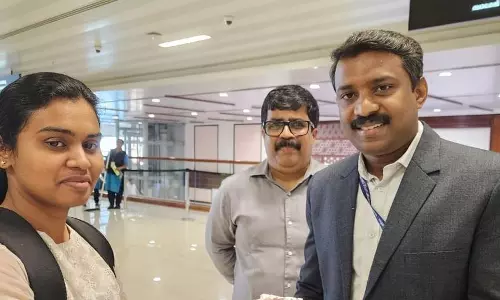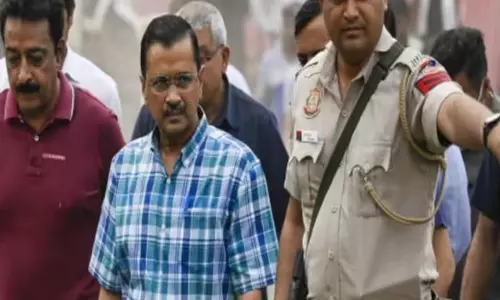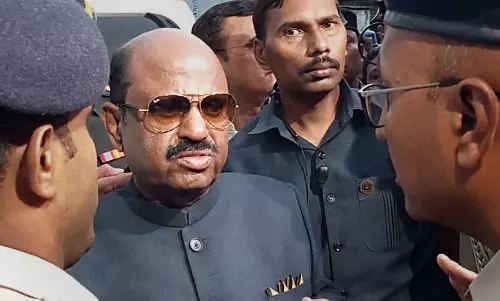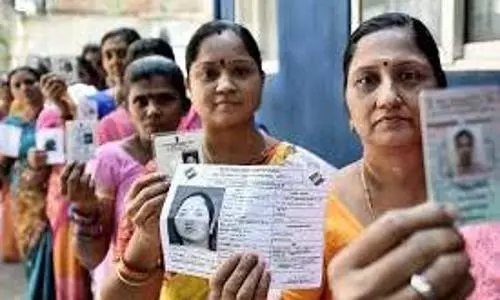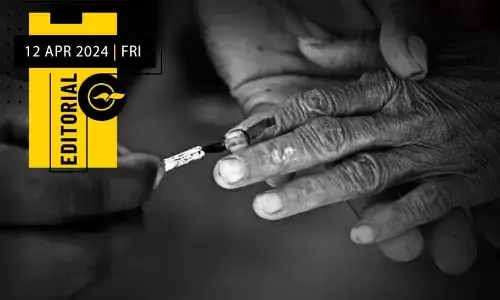
Left determined Bengal's fate in 2019: An argument less convincing, yet true
text_fields2019 Lok Sabha election result is immensely important as it has redefined not only the future of India but also the politics of Bengal, a state I belong to. A state which had 34 years long uninterrupted Left rule and 10 years rule of a social democratic party (All India Trinamool Congress-AITC). Bengal is suddenly overwhelmed to face the fact that BJP has won 18 LS seats out of 42 from the state.
AITC is still ahead with 22 seats but the difference in vote share between these two parties is just 3%. BJP has increased its vote share from a mere 17% to 40%, leaving INC and Left far behind. While Left suffered the major setback in terms of vote and seat shares (vote percentage reduced by around 22% and with no seat), INC too suffered around 4% loss in their vote share but managed to win 2 seats. All Left candidates, excepting one, lost their security deposits.
Yet it is Left which has determined the overall results in Bengal, despite being out of power in the last one decade. On one hand while it is true that traditional Left votes have been transferred to BJP in huge number, on the other hand the fact that Left indirectly helped AITC to get 8 seats can’t be overlooked. When we look at constituency wise vote share, it becomes evident that if Left candidates failed to get some decent percentage votes in 8 constituencies and if those votes went to BJP, AITC would have lost 8 more seats and BJP would have gained 8 seats more. Therefore, the simple argument that all Left votes went to BJP does not hold ground. Left fought tooth and nail, where they had some base and retained a percentage of vote share, which helped AITC. But in many places where Left was too weak to put up any fight at all, BJP gained immensely from traditional Left vote banks.
Overall the result is indicative that Bengal has emerged as the new laboratory for BJP’s experiments in Eastern states of India, undoubtedly along communal lines. Immediately after the results came, people’s reactions were ranging between disbelief and delight. But for political analysts, majority of whom are now proven wrong in their Bengal prediction and for politicians, it is high time to reflect on multidimensional factors which have painted half of Bengal in saffron and wiped out red from the electoral map.
Before election, during interactions with different people from various walks of life, I remember a few indicative conversations. The Muslim girl who is our domestic help for years come from a staunch Left supporter family. One morning I overheard her conversation with my mother on how local Left leaders urged her father to vote for BJP as BJP could defeat Mamata Banerjee. She added that her father was taken aback and repeated that he always voted for Left and would continue to vote for Left irrespective of outcome. In another case narrated to me by a friend, when she reached a suburban area to campaign for Left, during interactions an elderly poor Muslim fruit vendor came forward and said, “Throughout my life I voted for Left but this time I will vote for BJP, as Left will not be able to give us protection anymore".
Similarly, another close friend of mine, a Hindu upper caste man and staunch Left supporter, called me one evening and explained the pain he and his family were going through, as this would be the first time, they would vote for AITC. When I asked the reason, there was an outburst: "Left has weakened, it has lost all relevance, it will not be able to stop BJP, Left has stubbornly refused to go for any pre-poll alliance with other parties, leaving us helpless; how can we contribute to victory of BJP?"’ I had no answer to his question. Yet in another conversation one of my Hindu neighbours, a bank employee and member of AITC employee’s union, stated openly he would vote for BJP. He kept complaining about BJP’s failed economic policies, poor economic condition of the state and rising nation-wide unemployment. He lamented that his educated son was unemployed for years. But he would vote for BJP. When asked why, his answer was simple "No party has any solution to economic crisis but BJP is al least a Hindu party, so it is my party’’. Another school teacher friend of mine, a former Left supporter revealed that her vote would be for BJP in 2019 as both Left and AITC appeased minorities and neglected majorities in the state. These snapshots only reveal how divided Bengal was before election and how different parties either overlooked these or played roles to widen that divide, instead of bridging the gap.
When poll results are out, the data clearly shows a bulk shift of traditional Left supporters to the saffron camp, even a little to AITC as the ruling state party has increased its vote share by around 4%. Whether dictated by central party leaders or not (which is difficult to believe) local Left leaders in many places not only openly campaigned for BJP but also took part in celebration, post result, together with BJP. Why did they do so? A local Left leader explained to me: “We will defeat Mamata this time, her party will disintegrate (it is no secret that AITC is not a cadre based party) and as a result all our traditional votes will return to us, before 2021 assembly election and we then will emerge as the main opposition of BJP and will defeat BJP fully’ I was speechless. This tendency of supporting BJP by local Left became so strong that former CM and veteran Left leader Buddhadeb Bhattacharjee made a statement just before poll and clarified that the first enemy of Left was BJP and not AITC. But it was too little, too late.
Why did AITC perform poorly? There are multiple reasons. Lack of disciplined cadres, nepotism, local level arrogance of leaders and exploitation of commons, lack of second line leadership, failure to handle inner party conflicts etc are worth mentioning. Together with external factors like pan-India saffron surge, pressure from centre on various fronts (alleged scams etc), financial crunch and inability to hike salaries of state government employees, failure in creation of new job opportunities, tall but empty claims of increasing farmers’ income, unleashing violence during Panchayat elections in some pockets and restricting voters from voicing their opinions freely are a few prominent factors to ponder over. Last but not the least, falling in the trap of BJP and playing the same communal card, be it announcing a monthly allowance for Imams (later rejected by the court), providing donations to thousands of Durga Puja committee (this too was restricted by court to some extent), inability to handle Muharram and Durga idol immersion controversy in a more matured way (though the intention was never communal), all backfired for AITC and gave BJP an edge.
BJP on the other hand invested huge amount of money and muscle power in Bengal as per their plan of conquering East. The party twisted every incident which had a potential Hindu-Muslim dimension and catered it to majority as ‘minority appeasement of AITC’. The communal hatred was triggered systematically by instigating many minor riots all over Bengal in last three years and each riot increased polarisation thus benefitting only BJP. At the last stage of election campaign, the blatant show of money and muscle power by BJP was unprecedented in Bengal politics, which is known for its simplicity and refined culture. Crude slogans, communal provocation, armed processions led by star campaigners of BJP, pulled crowds. AITC tried to campaign hard but was no match to BJP. Other parties were almost mere spectators.
BJP successfully revived the caste conflict too. It made significant inroads in all border states (with Bangladesh) based on their aggressive anti-Muslim narrative and promise of NRC, a promise to take stringent action against illegal Muslim and Christian immigrants while embracing Hindu illegal immigrants as citizens. Though we all know what is happening in Assam in the name of NRC, where both Hindus and Muslims are suffering enormously, the majoritarian communalism, which was always a reality of a partition-affected state like Bengal, got attracted to this promise of teaching ‘Muslims a lesson’. BJP successfully shaped the election narrative in past mode, it promised to ‘Correct’ the past for the majority. In a nutshell, BJP, like elsewhere, played the Hindutva card very strongly in Bengal and has been successful in polarising Hindu votes in Bengal over religion, perhaps for the first time ever since independence. BJP did not even try to fight election in Bengal on economic issues, not even much on national security issues, it was purely the anti-minority issue which made BJP acceptable among the Hindu majority of Bengal.
It makes little sense to discuss the role of INC in Bengal, as it is almost non-existent. There had been an informal understanding between Left and INC in some pockets, during election, which only benefitted INC and they were able to get 2 seats from the state, with minimum campaign and visibility and with no alternative narrative or state leadership.
Now that the 2019 battle is over, we all are trying to grapple with the lessons learnt. There are different opinions. The most dominant one is politics of polarisation. AITC is blamed for minority appeasement without any real reason. But in a post-truth world, a lie repeated 100 times becomes truth. In her most recent Press conference after LS 2019 result, a visibly angry Mamata Banerjee shouted at the press “I am going to an iftar party now, do join me. I do Muslim appeasement, so I must take care of them who stood by me’. This dark sarcasm was deliberately misinterpreted by many media and it made headlines that Mamata openly accepted her Muslim appeasement strategy. Her other statements escaped media attention, where she said: “I worked for people, I worked for poor but if people are not happy what can I do?” her frustration was wrongly timed, as many started interpreting this as her sign of resignation or announcement of defeat for 2021.
There is no doubt 2021 would be the toughest ever assembly election in Bengal. The next two years would be an ordeal for Bengal. There are already reports of BJP attacking AITC supporters, vandalising AITC offices. AITC however, so far has shown restraint, which is wise. Bengal will have state election in 2021 as per schedule. No matter how regressive it sounds, vote bank politics will play a crucial role. Therefore, for AITC, minority and semi urban, urban middle-class vote banks would remain crucial. But it must figure out how it would regain trust of a sizeable part of majority vote, across the state. Curbing local corruption and hooliganism will help to some extent but probably not enough as the communal scar of Bengal has again started bleeding, thanks to the overtly communal politics of BJP and lack of counter narrative of other parties. Will Left be able to come back as per their dream? At this point the hope is dim. It may be easy for some Left leaders to transfer votes to BJP by influencing some traditional supporters, but once in BJP these voters would be exposed to a new culture and privileges. There is no guarantee that they would listen to the plea of Left leaders readily in 2021. Money and muscle power played extremely important role in 2019 election and Bengal was no exception. BJP has no competition in this regard. The super-rich party has thin opposition at the Centre now, key pillars of democracy are dwindling. There were many questions raised about the role of ECI and EVMs during LS 2019, which will most probably remain unanswered.
Bengal has got a new narrative from BJP, outright communal yet closer to heart of many majority Hindus, economy played a marginal role in determining voting patterns, as evident from past elections in Bengal, India and abroad. Therefore, it would be interesting to observe how Bengal politics unfold in coming months. How are parties positioning themselves and which issues ae emerging as priorities? However, one thing is clear from pan-India experience: soft Hindutva will not defeat hard Hindutva! Will secular politics, politics of real issues make a come back in Bengal? Or will Bengal go with the North belt communal politics? The state has always surprised Indian politics, we may hope for another surprise, sooner or later from Bengal.




